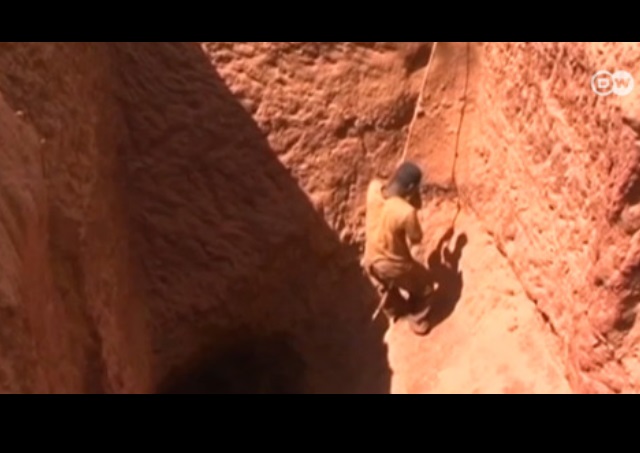Suspension notices handed to 16 of 36 Manica mining companies after ‘business as usual’ ...
Mozambique: Illegal miners again invade ruby mining – AIM report

FILE: For illustration purposes only. [Screen grab: DW]
Hundreds of illegal miners on Saturday invaded the mining concession granted to the company Montepuez Ruby Mining (MRM) in the northern province of Cabo Delgado, and attacked MRM security guards, seriously injuring two of them.
According to the report of the invasion in Monday’s issue of the independent daily “O Pais”, about 350 miners, both Mozambicans and Tanzanians, attacked the mining area in the small hours of Saturday morning.
They ambushed a security vehicle and attacked the three security guards inside, using pickaxes and machetes against them.
One of the guards, Custodio Juliano, who is undergoing treatment in the hospital in the provincial capital, Pemba, told reporters he believed the illegal miners wanted to kill him and his colleagues, but the arrival of rescuers stopped them.
“I took three blows from a pickaxe”, said Juliano, “The first was in my back, and the second on my head, almost completely splitting my lip. The last blow was on my buttocks”.
“The last thing I remember hearing before I lost consciousness was one of the miners asking a friend to give me the final blow”, he said, convinced that he was going to die.
However, he woke up in hospital, alongside a colleague, who is still under observation due to the severe head injuries he sustained.
MRM has confirmed the Saturday invasion and suspects that the illegal miners had been organised by a gang of international traffickers in precious stones.
“Last Tuesday, 18 February, some illegal foreigners in the country circulated a false message indicating that a ruby mine, known as Maningue Nice, would be opened to the population as from Saturday, supposedly on the orders of the head of state”, the MRM Executive Director, Asghar Faqhr, told reporters.
The invasion was predictable, Faqhr said, because the previous day the Namanhumbir administrative post, where the mine is located, was full of informal miners, supposedly waiting for an opportunity to enter legally the MRM concession area.
“On Friday, about 2,000 informal miners spent the night in Nanhopo and Namanhumbir villages, near the Maningue Nice mine, which would supposedly open to the public on Saturday”, he added. MRM issued a denial of the fake message, which was carried by local media.
But the invasion went ahead. “From the tactics they used to ambush the company’s security guards, we know they are people with military training. They have also completely mastered the system of corruption”, said Faqhr, as he urged the authorities to restore order in the concession area.
This is the second mass invasion of the MRM area in less than a month. Hundreds of illegal miners entered shafts at the Manungue Nice 3 mine on 4 February. Despite three lethal collapses of shafts within as many days, the remaining miners kept digging. By 6 February, when the last of the illegal miners withdrew, 11 of them had died.
These tragedies occur repeatedly, as illegal miners return time and again to the MRM area despite the dangers. According to official data, 14 people were buried alive in the mine shafts in 2019.
Namanhumbir contains one of the largest deposits of rubies in the world, which attracts criminals from across the globe, who exploit the illegal miners. The networks of ruby smugglers pay the miners a pittance for the stones they extract at great risk to their lives.
An MRM investigation into the illegal trade last year found that the great majority of the illegal miners were not from Cabo Delgado, but from the neighbouring province of Nampula, and they were trapped into making payments to the ruby smuggling syndicates.
Some of them had been asked to make a payment to the syndicates in order to be granted the “opportunity” to mine and be provided with transport to, and food and accommodation in, the Montepuez area. MRM found that when they could not pay these fees at once, “the syndicates offer to provide a loan which the illegal miner is to repay later from his ruby mining activities, thereby placing the miner in debt with the syndicate”.
The syndicate takes the rubies dug by the illegal miners and sells them on higher up the ruby smuggling chain. “The illegal miner receives only a fraction of the sums involved”, said MRM. “Indebted to the syndicates and with no spare cash, these illegal miners cannot freely return home”.
The MRM investigation concluded “that these illegal miners are deliberately being put into debt bondage by middlemen and syndicate leaders, who exploit conditions of poverty and unemployment in struggling communities, thereby practicing a form of modern-day slavery”.
MRM is the only company authorised to mine rubies in Namanhumbir. Since 2014 its auctions of rubies, mostly in Singapore, have raised about 500 million US dollars. Over this period, MRM has paid taxes of about 150 million dollars to the Mozambican state, and a further five million for social responsibility actions.
75 per cent of MRM is owned by the British gem company, Gemfields, and the remaining 25 per cent is held by the Mozambican company Mwiriti.













Leave a Reply
Be the First to Comment!
You must be logged in to post a comment.
You must be logged in to post a comment.